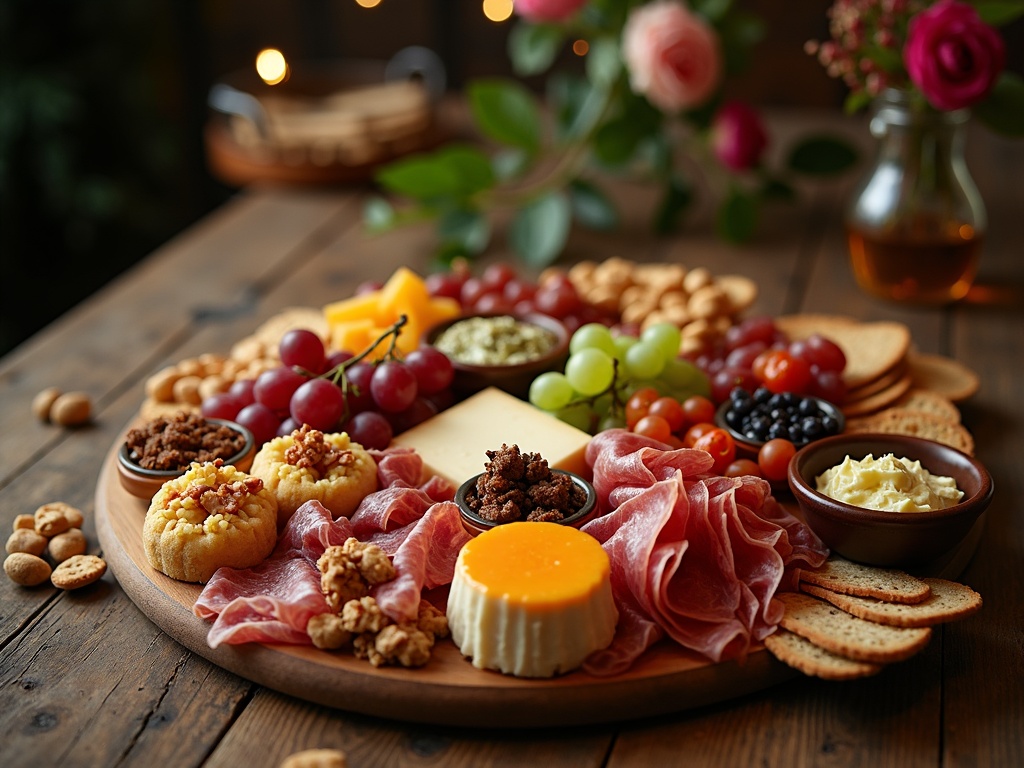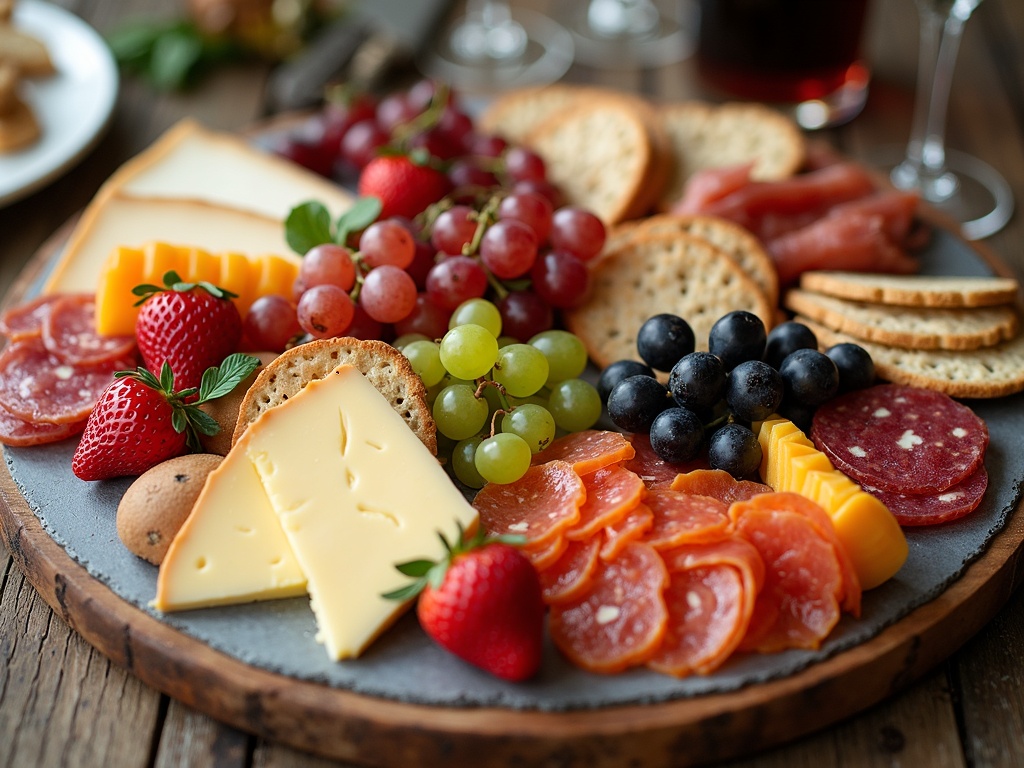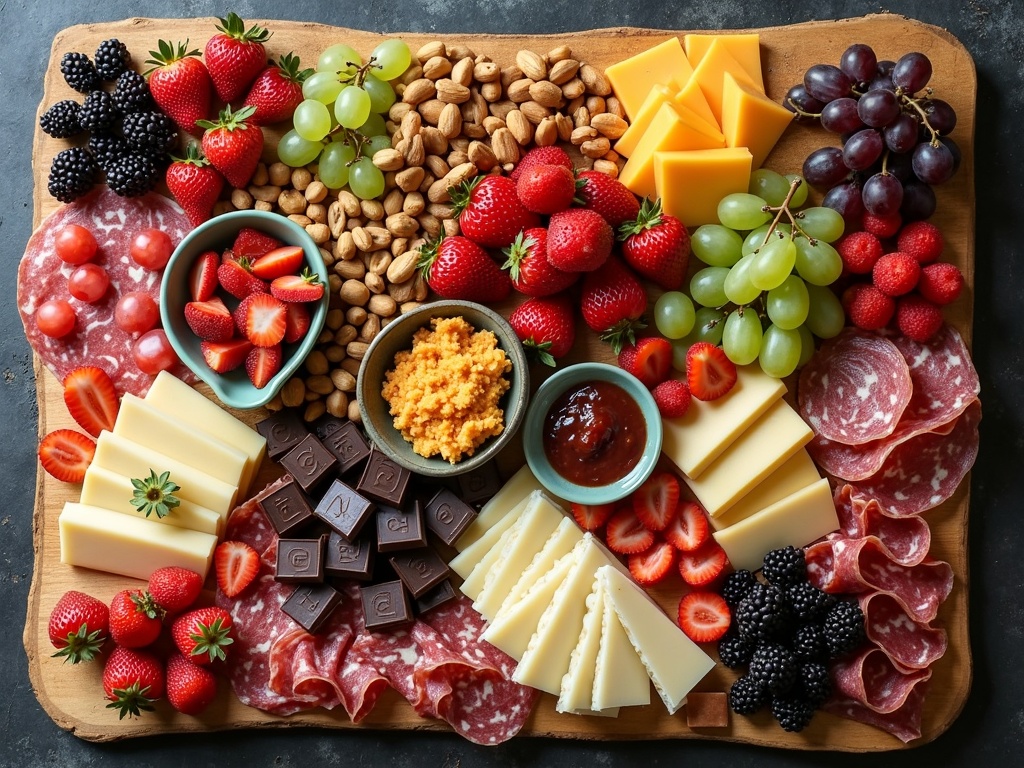Charcuterie board variations have evolved from traditional meat and cheese platters into diverse culinary showcases that reflect personal style, dietary preferences, and seasonal inspirations. Whether featuring plant-based alternatives, sweet dessert combinations, or holiday-themed arrangements, these customizable spreads have transformed home entertaining with their visual appeal and interactive dining experience.
Find In This Article
Key Takeaways
- A well-balanced traditional charcuterie board typically includes 2-4 premium meats, 2-4 complementary cheeses, fresh fruits, nuts, savory spreads, and assorted crackers.
- Plant-based charcuterie boards can be equally impressive with components like various hummus flavors, olives, pickled vegetables, roasted vegetables, and dairy-free cheese alternatives.
- Sweet charcuterie boards feature chocolates, pastries, fresh fruits, and dessert spreads, with Pinterest searches for these increasing by 75% in 2022.
- Seasonal ingredients enhance charcuterie boards, with 80% of consumers prioritizing seasonal and local items for improved flavor and visual appeal.
- A thoughtful beverage pairing (both alcoholic and non-alcoholic) and creative presentation techniques significantly elevate the charcuterie experience.
Why Charcuterie Board variations Are the Ultimate Party Platter
I’ve found that charcuterie boards have revolutionized entertaining at home, offering a perfect blend of simplicity and sophistication. These customizable platters bring together complementary flavors that guests can enjoy at their own pace. The casual, communal dining experience they create has captured the hearts of many hosts and guests alike.
Perfect Balance of Components
A well-crafted charcuterie board typically includes a thoughtful selection of ingredients:
- 2-4 premium meats (salami and prosciutto reign supreme)
- 2-4 complementary cheeses (sharp cheddar and creamy brie are staples)
- Fresh seasonal fruits that add sweetness and color
- Crunchy nuts for texture contrast
- Savory spreads that tie flavors together
- Assorted crackers and bread for building the perfect bite
This careful arrangement serves 4-6 people comfortably, making it ideal for intimate gatherings. The beauty lies in how these elements interact, creating countless flavor combinations for guests to discover.
Why They’ve Become an Entertaining Essential
The statistics speak for themselves—over 60% of consumers prefer casual dining experiences like charcuterie. This trend reflects our shifting social preferences toward relaxed, interactive dining that encourages conversation.
I appreciate how these boards eliminate the need for formal seating arrangements. Guests can mingle freely while sampling different combinations throughout the event. The visual appeal can’t be understated either—a thoughtfully arranged board becomes both a feast for the eyes and palate.
For hosts, charcuterie offers particular advantages. I can prepare everything in advance, meaning I’m not stuck in the kitchen during my own gathering. The versatility allows me to accommodate various dietary preferences by incorporating fresh vegetable options alongside traditional cured meats.
The board itself acts as a conversation starter, with guests discussing their favorite combinations or discovering new pairings. This interactive element transforms eating into a shared experience rather than just a meal.
When paired with complementary beverages, like sparkling juice or coffee, the flavors reach new heights. I often include small savory appetizers to round out the offering and ensure there’s something for everyone’s taste preferences.

Plant-Based Boards That Impress
The plant-based food market reached a staggering $7 billion in 2021, with a 27% growth in plant-based options since 2019. This explosion in popularity has extended to entertaining, where I’ve seen plant-based charcuterie boards become showstoppers at gatherings. These beautiful spreads can be just as impressive as their meat-filled counterparts, offering vibrant colors and complex flavors that appeal to everyone at the table.
Core Components for a Stunning Spread
Creating a memorable plant-based board starts with thoughtfully selected core ingredients:
- Hummus varieties (classic, roasted red pepper, beetroot) serve as creamy anchor points
- Olives in different colors and flavors add briny contrast
- Pickled vegetables provide tang and crunch
- Roasted vegetables like bell peppers, zucchini, and eggplant offer rich, caramelized flavors
- Dairy-free cheese alternatives including cashew-based spreads, almond feta, and coconut-based brie
The arrangement is just as important as the ingredients themselves. I’ve found that creating artistic tapas-style layouts with varying heights and textures draws guests in. Try placing items in small waves or clusters rather than straight lines, and use fresh herbs as dividers between sections.
Don’t forget to include popular crowd-pleasers like marinated artichoke hearts, sundried tomatoes, and fresh greens as garnish to add color. For a sweet element, dried fruits and dark chocolate pieces provide perfect balance.
The bread and cracker selection matters too. Offer a variety of artisanal bread options including seeded crackers, flatbreads, and gluten-free alternatives to accommodate all dietary needs.
For added flavor complexity, include small pots of interesting condiments – fig jam, hot honey, grain mustard, or balsamic glaze. These extras allow guests to create their own perfect bite combinations.
What makes plant-based boards truly special is their visual appeal. Using wooden boards, slate tiles, or marble surfaces as your base creates a natural, rustic backdrop for your colorful spread. Small ceramic bowls add height variation and contain messier items like dips and spreads.
These plant-based alternatives don’t just satisfy dietary preferences – they’ve become statement pieces in their own right, proving that plant-based entertaining can be both ethical and spectacular.
Sweet and Celebratory Spreads
Creating a sweet charcuterie board offers a delightful twist on the traditional savory version. I’ve found that balancing 4-8 sweet components provides the perfect variety without overwhelming guests. These dessert-focused boards have surged in popularity, with Pinterest searches for “Dessert Charcuterie Board” increasing by 75% in 2022 alone.
Essential Sweet Board Components
A successful sweet board starts with a thoughtful selection of core elements. I always include these foundation items:
- Chocolates: Mix dark, milk, and white varieties with different fillings or toppings
- Pastries: Mini croissants, cookies, brownie bites, or sweet pastry variations cut into bite-sized pieces
- Fresh fruits: Strawberries, grapes, sliced apples, and other seasonal options add freshness and color
- Spreads: Nutella, caramel sauce, chocolate ganache, and fruit preserves in small dipping bowls
- Nuts and extras: Candied nuts, dried fruits, and honey sticks create texture contrasts
When arranging your board, I recommend creating little clusters of complementary items. For instance, place strawberries near chocolate dip and cookies near spreads. This arrangement doesn’t just look attractive but makes logical sense for your guests.
Sweet boards pair wonderfully with dessert wines or coffee. For coffee pairings, consider offering both regular and decaf options alongside flavored creamers. If serving dessert wines, moscato and late-harvest riesling complement sweet nibbles particularly well.
Kid-friendly versions have become especially popular at birthday parties and family gatherings. I’ve had great success with boards featuring:
- Colorful candies organized by shade
- Mini donuts and cupcakes
- Marshmallows and graham crackers for DIY s’mores
- Fruit skewers with yogurt dips
- Cookie decorating stations with icing and sprinkles
For celebrations, theme your board accordingly. Valentine’s Day boards might feature heart-shaped chocolates and red fruits, while holiday versions could incorporate seasonal cookies and festive treats like peppermint bark.
Don’t forget presentation matters tremendously for sweet boards. I use tiered stands for special occasions to create vertical interest. Small bowls and ramekins keep sticky items contained, while fresh herbs like mint can add an elegant finishing touch.
For breakfast or brunch gatherings, consider a morning-appropriate sweet board featuring:
- Mini pancakes or waffles with maple syrup
- Yogurt parfait ingredients
- Breakfast pastries and muffins
- Cream cheese with sweet toppings
- Fresh fruit with honey or chocolate sauce
Sweet boards can also be tailored for specific dietary needs. For vegan guests, dark chocolate, fruit leather, and plant-based spreads work beautifully. For gluten-free options, include macarons, chocolate-dipped fruits, and specialty cookies.
The beauty of sweet charcuterie lies in its adaptability and visual appeal. By mixing textures, flavors, and colors while considering the occasion, I’ve found these boards become the centerpiece of any celebration.
Seasonal and Holiday Specialties
I’ve found that creating charcuterie boards that reflect the current season adds both visual appeal and flavor complexity. According to recent surveys, 80% of consumers prioritize seasonal and local ingredients when selecting food options, making seasonal charcuterie boards increasingly popular for gatherings and celebrations.
Seasonal Inspirations
Autumn brings rich, comforting flavors that transform any charcuterie board into a harvest celebration. I like to incorporate:
- Small roasted pumpkin segments drizzled with honey
- Dried or fresh cranberries for tart contrast
- Seasonal cheeses like smoked gouda or aged cheddar
- Cinnamon-spiced nuts and apple slices
- Fig jam or maple butter for spreads
Summer charcuterie boards call for lighter, refreshing elements that won’t wilt in warmer temperatures. These summer-inspired tapas options work beautifully on a board:
- Fresh berries (strawberries, blueberries, raspberries)
- Herbs like basil and mint as garnishes and flavor enhancers
- Light cheeses such as fresh mozzarella or goat cheese
- Cucumber slices and cherry tomatoes
- Honey or citrus-infused dips
Holiday Themes and Local Sourcing
Holiday gatherings present perfect opportunities for themed charcuterie creations. For winter celebrations, I arrange ingredients in festive shapes or incorporate red and green elements through artisanal cheese selections paired with dried fruits. Spring holidays benefit from pastel-colored additions like watermelon radishes or edible flowers.
Local sourcing elevates any seasonal board while supporting regional producers. I follow these guidelines:
- Visit farmers markets for unique, in-season produce
- Connect with local cheesemakers for specialty items
- Source meats from regional butchers or specialty shops
- Ask vendors about peak seasonality for optimal flavor
- Consider preserving seasonal items (like making jam from summer berries) for year-round use
The most successful pairings often come from what’s naturally available together. Spring boards feature asparagus, peas, and young cheeses, while winter boards showcase hearty cured meats with preserved fruits. I’ve noticed guests particularly appreciate learning about local specialty items and their seasonal significance when presented on a thoughtfully curated board.
Perfect Pairings and Presentation
Creating a stunning charcuterie board goes beyond just selecting quality ingredients—it’s also about thoughtful pairings and eye-catching presentation. I’ve found that the right beverage pairing can elevate the entire experience, making flavors pop and creating memorable moments for guests.
Beverage Pairings That Elevate Your Board
It’s no surprise that approximately 70% of charcuterie boards are served alongside drinks, making beverage pairings an essential consideration. When matching wines with your spread, I recommend bold reds like Cabernet Sauvignon or Syrah with aged cheeses—the tannins complement the rich, nutty flavors perfectly. For softer cheeses like brie or camembert, a crisp Chardonnay or sparkling wine cuts through the creaminess and cleanses the palate.
Beer enthusiasts have plenty of options too. I pair hoppy IPAs with sharper cheeses, while Belgian-style ales work beautifully with cured meats like salami and chorizo selections. Darker stouts can stand up to more intense blue cheeses, creating a surprisingly balanced combination.
For spirit lovers, consider these winning combinations:
- Bourbon with aged cheddar or gouda
- Scotch with blue cheese or smoked meats
- Gin with fresh chevre and herb-infused accompaniments
Not everyone drinks alcohol, which is why I always include non-alcoholic options. Sparkling water with fresh fruit infusions makes a refreshing counterpoint to rich board components. Craft sodas, especially those with herbal notes like juniper or rosemary, can mimic the complexity of alcoholic drinks. For a truly sophisticated option, tea can be an unexpected delight—try pairing Earl Grey with Mediterranean elements or chai with spiced nuts and dried fruits.
Presentation Matters
When it comes to presentation, think of your board as edible art. I create visual interest by varying heights and textures—folding or rolling meats rather than laying them flat, and cutting cheeses in different shapes. Color contrast is crucial too; intersperse bright fruits like strawberries or grapes among the neutrals of cheeses and meats.
Temperature management makes a huge difference in flavor experience. I remove hard cheeses from refrigeration about 30-45 minutes before serving to allow flavors to develop, while keeping soft cheeses chilled until about 15-20 minutes before guests arrive. Fruits and vegetables should be fresh and cool, while bread and crackers are best at room temperature.
Don’t forget to include small serving utensils for each component—dedicated cheese knives for different textures and small tongs for pickled items or fresh vegetable garnishes. This not only looks more polished but also prevents flavor mixing.
The vessel matters too—wooden boards provide rustic charm, while slate or marble offers elegant contrast. I sometimes use multiple smaller boards for larger gatherings, creating themed cheese and meat stations throughout the space.
For a final touch, add descriptive labels for unusual items or suggest specific pairings directly on the board with small cards. This interactive element encourages guests to experiment with different combinations and sparks conversation about flavors—turning your charcuterie board from simple snacking into a full sensory experience that guests will remember.

Sources:
2022 Food Trends Report, American Culinary Federation
2021 Plant-Based Foods Association Growth Report
Gourmet Food Trends, Pinterest Trends Data 2022
Diner Trends 2023, National Restaurant Association
The Rise of Seasonal Eating, Harvard Food Review

